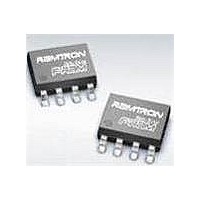FM25V10-G Ramtron, FM25V10-G Datasheet - Page 3

FM25V10-G
Manufacturer Part Number
FM25V10-G
Description
F-RAM 1M (128Kx8) 2.0-3.6V
Manufacturer
Ramtron
Datasheet
1.FM25V10-G.pdf
(16 pages)
Specifications of FM25V10-G
Organization
128 K x 8
Operating Supply Voltage
2 V to 3.6 V
Operating Temperature Range
- 40 C to + 85 C
Mounting Style
SMD/SMT
Memory Size
1 Mbit
Interface
SPI
Package / Case
SOIC-8
Lead Free Status / RoHS Status
Lead free / RoHS Compliant
Available stocks
Company
Part Number
Manufacturer
Quantity
Price
Company:
Part Number:
FM25V10-G
Manufacturer:
ADI
Quantity:
2 577
Part Number:
FM25V10-G
Manufacturer:
CYPRESS/赛普拉斯
Quantity:
20 000
Part Number:
FM25V10-GTR
Manufacturer:
CYPRESS/赛普拉斯
Quantity:
20 000
Overview
The FM25V10 is a serial F-RAM memory. The
memory array is logically organized as 131,072 x 8
and is accessed using an industry standard Serial
Peripheral Interface or SPI bus. Functional operation
of the F-RAM is similar to Serial Flash. The major
differences between the FM25V10 and a Serial Flash
with the same pinout are the F-RAM’s superior write
performance, very high endurance, and lower power
consumption.
Memory Architecture
When accessing the FM25V10, the user addresses
128K locations of 8 data bits each. These data bits are
shifted serially. The addresses are accessed using the
SPI protocol, which includes a chip select (to permit
multiple devices on the bus), an op-code, and a three-
byte address. The complete address of 17-bits
specifies each byte address uniquely.
Most functions of the FM25V10 either are controlled
by the SPI interface or are handled automatically by
on-board circuitry. The access time for memory
operation is essentially zero, beyond the time needed
for the serial protocol. That is, the memory is read or
written at the speed of the SPI bus. Unlike Serial
Flash, it is not necessary to poll the device for a ready
condition since writes occur at bus speed. So, by the
time a new bus transaction can be shifted into the
device, a write operation will be complete. This is
explained in more detail in the interface section.
Users expect several obvious system benefits from
the FM25V10 due to its fast write cycle and high
endurance as compared to Serial Flash. In addition
there are less obvious benefits as well. For example
in a high noise environment, the fast-write operation
is less susceptible to corruption than Serial Flash
since it is completed quickly. By contrast, Serial
Flash requiring milliseconds to write is vulnerable to
noise during much of the cycle.
Serial Peripheral Interface – SPI Bus
The FM25V10 employs a Serial Peripheral Interface
(SPI) bus. It is specified to operate at speeds up to
40MHz. This high-speed serial bus provides high
performance
microcontroller. Many common microcontrollers
have hardware SPI ports allowing a direct interface.
It is quite simple to emulate the port using ordinary
port pins for microcontrollers that do not. The
FM25V10 operates in SPI Mode 0 and 3.
Rev. 2.0
May 2010
serial
communication
to
a
host
Protocol Overview
The SPI interface is a synchronous serial interface
using clock and data pins. It is intended to support
multiple devices on the bus. Each device is activated
using a chip select. Once chip select is activated by
the bus master, the FM25V10 will begin monitoring
the clock and data lines. The relationship between the
falling edge of /S, the clock and data is dictated by
the SPI mode. The device will make a determination
of the SPI mode on the falling edge of each chip
select. While there are four such modes, the
FM25V10 supports only modes 0 and 3. Figure 2
shows the required signal relationships for modes 0
and 3.
FM25V10 on the rising edge of C and data is
expected on the first rising edge after /S goes active.
If the clock starts from a high state, it will fall prior to
the first data transfer in order to create the first rising
edge.
The SPI protocol is controlled by op-codes. These
op-codes specify the commands to the device. After
/S is activated the first byte transferred from the bus
master is the op-code. Following the op-code, any
addresses and data are then transferred.
Certain op-codes are commands with no subsequent
data transfer. The /S must go inactive after an
operation is complete and before a new op-code can
be issued. There is one valid op-code only per active
chip select.
SPI Mode 0: CPOL=0, CPHA=0
SPI Mode 3: CPOL=1, CPHA=1
For both modes, data is clocked into the
Figure 2. SPI Modes 0 & 3
FM25V10 - 1Mb SPI FRAM
Page 3 of 16












